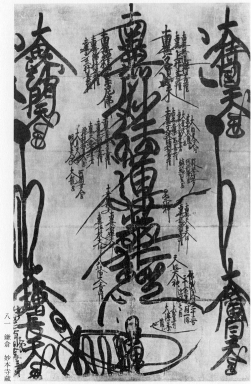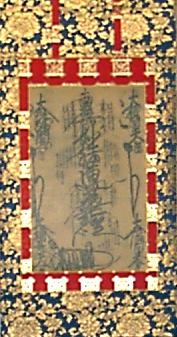The Vidyarajas
Myo-o ~ Knowledge Kings
These esoteric deities are the kings of mystic knowledge who
represent the power of the Buddhas to vanquish blind craving.
They are known as the the kings of mystic knowledge because they
wield the mantras, which are the mystical spells made up of
Sanskrit syllables imbued with the power to protect practitioners
of the Dharma from all harm and evil influences. The Vidyarajas
appear in terrifying wrathful forms because they embody the
indomitable energy of compassion which breaks down all obstacles
to wisdom and liberation.
There are two groups of Vidyarajas which are well known. The
most famous is the group of five led by Fudo Myo-o. These five are the emanations of the Buddhas of the four cardinal directions
and the center which figure prominently in esoteric Buddhist
practice. There is also a group of eight, which includes Aizen Myo-o, who are emanations of bodhisattvas.
The two Vidyarajas who appear on the Omandala are Achalanatha
and Ragaraja, known in Japanese as Fudo Myo-o and Aizen Myo-o respectively. The are each represented by their respective bijas, "seed syllables" that embody their
essence. In this case, the seed syllables are written in Siddham,
a variant of Sanskrit. They are the only parts of the Omandala
written in the form of Sanskrit bijas. According to Jacqueline
Stone, Fudo Myo-o and Aizen Myo-o represent, "respectively,
the doctrines of 'samsara is nirvana' (shoji soku nehan)
and 'the defilements are bodhi' (bonno soku bodai)."
(Original Enlightenment, p.277) The first principle
means that nirvana is not another realm but the true reality of
the world of birth and death. The second principle means that
bodhi, or enlightenment, is not the eradication of the
defilements, but their liberation and transmutation into the
wholesome energy of the enlightened mind.
Fudo Myo-o and Aizen Myo-o are sometimes identified with the
Ni-o, the Two Kings, who are a dual form of Mahavairochana
Tathagata (Dainichi Nyorai), who is a personification of the
Dharmakaya or universal body of the Buddha. As such, Fudo Myo-o
represents the element of spirit or mind, the Diamond World
Mandala, and subjective wisdom; while Aizen Myo-o represents the
five elements of earth, air, fire, water, and space, as well as
the Womb World Mandala, and objective truth. Together the pair
represent all of the things which are united in the universal
life of the Buddha - body and mind, wisdom and truth, and the two
mandalas. The Two Kings are often found guarding the main gates
to temple and monasteries as fierce giant warriors.
Vam
The bija for Achalanatha Vidyaraja ~ Fudo
Myo-o
The Flammarion Iconographic Guide: Buddhism states:
"Chiefly represented in Japan, Fudo Myo-o, by his
mystic name Joju Kongo, 'the eternal and immutable diamond',
is the chief of the five great kings of magic science. The
Sanskrit name for him, Acalanatha means 'immutable
lord'. He is the Vidyaraja of the dark green or black body,
the destroyer of the passions. In the doctrines of
esotericism he is considered as a 'body of metamorphosis' (Nirmanakaya)
of Vairocana, whose firmness of spirit and determination to
destroy evil he personifies. His symbol is a vertically held
sword around which winds a dragon (Japanese kurikara)
surrounded by flames. His halo of flames is thought to
consume the passions. He is described in many sutras and
particularly in the Mahavairocana-sutra. He assumes
'faced with obstacles, the energy of the adept himself', thus
demonstrating the power of compassion of Vairocana. His sword
aids him to combat the 'three poisons': greed, anger, and
ignorance. In the left hand he holds a lasso (pasa)
to catch and bind the evil forces and to prevent them from
doing harm. Fudo Myo-o, having taken a vow to prolong the
life of the faithful by six months and to give them an
unshakable resolution to conquer the forces of evil, is
sometimes invoked in this respect as the 'prolonger of
life'." (p.203)
The Guide also says:
"Due to his combative force, Fudo is invoked in many circumstances, chiefly against attacks of sickness - not
because he is considered as a healer, but as an effective
force to combat impurities and demons that cause illness. He
is also invoked for protection against persons feared to be
harmful and against spells cast by sorcerers. Fudo is also
often considered as the defender of Japan against attack from
external enemies. For all these reasons, he must be one of
the Buddhist deities most often invoked in Japan, and also
one of the most popular. The temples and sanctuaries
dedicated to him are found throughout the countryside, in
cities and at crossroads. Most of these temples belong to the
Shingon and Tendai sects. Members of the Nichiren sect also worship him, mainly as the 'protector of the state'."
(p.208)
Icon: A wrathful looking heavily muscled midnight blue
monster with two prominent fangs sitting in full lotus posture on
a rock and surrounded by flames. He holds an upright sword with a
three pointed vajra handle in his right hand and a lasso with
hooks in his left hand. He is dressed in green and red robes.
Hum
The bija for Ragaraja Vidyaraja ~ Aizen Myo-o
The Flammarion Iconographic Guide: Buddhism states:
"This Vidyaraja, who is venerated almost exclusively
in Japan, is a deity of conception. He is the king of the
magic science of attraction or of love. 'Aizen Myo-o
represents in fact the amorous passion as it appears
sublimated in the perspective of esotericism: victorious over
itself, not by suppression as normally taught, but by a
greater exaltation transmuted into a desire for Awakening.'
He is sometimes identified with a ferocious form of
Vairocana, although he is not one of the five great
Vidyarajas. " (p.213)
The Guide also says:
"He is represented with a wrathful appearance. His
colour is red, symbolizing the blood sweat of compassion. In
his headdress is the head of a lion, symbolic of strength and
of the five Great Buddhas. He has three eyes (to see the
'three worlds') and holds a lotus in the hand, symbolic of
the calming of the senses, among other things. His other
attributes are a bow and arrows. He has two round haloes
included in a large 'burning wheel', red in colour. His
half-open mouth reveals fangs." (p.214)
Finally, the Guide says:
"Aizen Myo-o is still venerated by the Japanese, and is often invoked in connection with petitions concerning love. Apart from this, he is not a popular deity except among artists, geishas and others in professions connected with matters of love." (p.214)
Icon: A wrathful looking heavily muscled red monster with
sharp teeth, three eyes, and six arms sitting in full lotus on a
lotus flower. One burning wheel forms an aureole around his head,
and a larger one surrounds his body. He holds a bow and arrows,
as well as a vajra and vajra bell, a lotus flower, and a pearl.
He wears a lion in his headdress.
|








